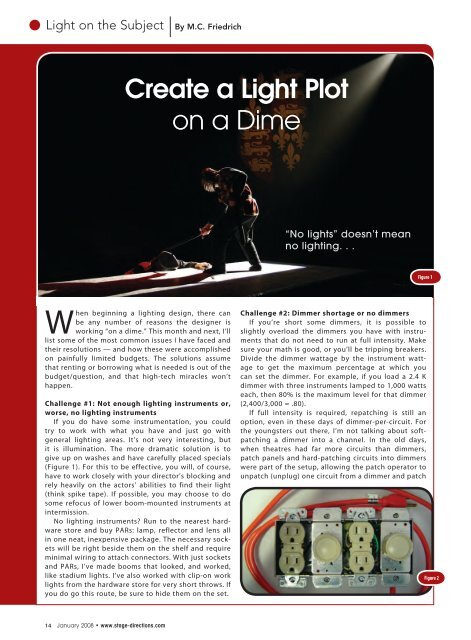Download a PDF - Stage Directions Magazine
Download a PDF - Stage Directions Magazine
Download a PDF - Stage Directions Magazine
You also want an ePaper? Increase the reach of your titles
YUMPU automatically turns print PDFs into web optimized ePapers that Google loves.
Light on the Subject<br />
By M.C. Friedrich<br />
Create a Light Plot<br />
on a Dime<br />
“No lights” doesn’t mean<br />
no lighting. . .<br />
Figure 1<br />
When beginning a lighting design, there can<br />
be any number of reasons the designer is<br />
working “on a dime.” This month and next, I’ll<br />
list some of the most common issues I have faced and<br />
their resolutions — and how these were accomplished<br />
on painfully limited budgets. The solutions assume<br />
that renting or borrowing what is needed is out of the<br />
budget/question, and that high-tech miracles won’t<br />
happen.<br />
Challenge #1: Not enough lighting instruments or,<br />
worse, no lighting instruments<br />
If you do have some instrumentation, you could<br />
try to work with what you have and just go with<br />
general lighting areas. It’s not very interesting, but<br />
it is illumination. The more dramatic solution is to<br />
give up on washes and have carefully placed specials<br />
(Figure 1). For this to be effective, you will, of course,<br />
have to work closely with your director’s blocking and<br />
rely heavily on the actors’ abilities to find their light<br />
(think spike tape). If possible, you may choose to do<br />
some refocus of lower boom-mounted instruments at<br />
intermission.<br />
No lighting instruments? Run to the nearest hardware<br />
store and buy PARs: lamp, reflector and lens all<br />
in one neat, inexpensive package. The necessary sockets<br />
will be right beside them on the shelf and require<br />
minimal wiring to attach connectors. With just sockets<br />
and PARs, I’ve made booms that looked, and worked,<br />
like stadium lights. I’ve also worked with clip-on work<br />
lights from the hardware store for very short throws. If<br />
you do go this route, be sure to hide them on the set.<br />
Challenge #2: Dimmer shortage or no dimmers<br />
If you’re short some dimmers, it is possible to<br />
slightly overload the dimmers you have with instruments<br />
that do not need to run at full intensity. Make<br />
sure your math is good, or you’ll be tripping breakers.<br />
Divide the dimmer wattage by the instrument wattage<br />
to get the maximum percentage at which you<br />
can set the dimmer. For example, if you load a 2.4 K<br />
dimmer with three instruments lamped to 1,000 watts<br />
each, then 80% is the maximum level for that dimmer<br />
(2,400/3,000 = .80).<br />
If full intensity is required, repatching is still an<br />
option, even in these days of dimmer-per-circuit. For<br />
the youngsters out there, I’m not talking about softpatching<br />
a dimmer into a channel. In the old days,<br />
when theatres had far more circuits than dimmers,<br />
patch panels and hard-patching circuits into dimmers<br />
were part of the setup, allowing the patch operator to<br />
unpatch (unplug) one circuit from a dimmer and patch<br />
Figure 2<br />
14 January 2008 • www.stage-directions.com

















